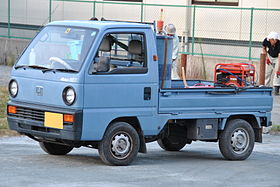Honda Acty
| Honda Acty | |
|---|---|
 |
|
| Overview | |
| Manufacturer | Honda |
| Production | 1977–present |
| Assembly |
Suzuka Plant, Suzuka, Mie, Japan Yachiyo Plant, Yokkaichi, Mie, Japan (starting 1985) |
| Body and chassis | |
| Class |
Microvan kei truck |
| Body style | 5-door Van 2-door Pickup truck |
| Layout | Mid-engine, rear-wheel drive / four-wheel drive. |
| Related | Honda Vamos |
| Chronology | |
| Predecessor |
|
| First generation | |
|---|---|

Pre-facelift Acty truck
|
|
| Overview | |
| Manufacturer | Honda |
| Also called | Honda Street |
| Production | July 1977–1988 |
| Body and chassis | |
| Body style |
|
| Layout | Mid-engine, rear-wheel drive / four-wheel drive. |
| Powertrain | |
| Engine | 545 cc EH SOHC 2-cylinder |
| Transmission | |
| Dimensions | |
| Wheelbase | 1,850 mm (73 in) |
| Length | 3,195 mm (125.8 in) |
| Width | 1,395 mm (54.9 in) |
| Height |
|
| Curb weight | 590 kg (1,300 lb) (truck) |
| Second generation | |
|---|---|

Acty truck (early)
|
|
| Overview | |
| Manufacturer | Honda |
| Also called | Honda Street |
| Production | March 1988–May 1999 |
| Body and chassis | |
| Body style |
|
| Layout | Mid-engine, rear-wheel drive / four-wheel drive. |
| Powertrain | |
| Engine | |
| Transmission | |
| Dimensions | |
| Wheelbase | 1,900 mm (75 in) |
| Length | 3,195–3,295 mm (125.8–129.7 in) |
| Width | 1,395 mm (54.9 in) |
| Height |
|
| Curb weight | 670–870 kg (1,480–1,920 lb) |
| Third generation | |
|---|---|
 |
|
| Overview | |
| Manufacturer | Honda |
| Production |
|
| Body and chassis | |
| Body style |
|
| Layout | Mid-engine, rear-wheel drive / four-wheel drive. |
| Related | Honda Vamos |
| Powertrain | |
| Engine | 656 cc E07Z SOHC I3 |
| Transmission | |
| Dimensions | |
| Wheelbase | 2,420 mm (95 in) |
| Length | 3,395 mm (133.7 in) |
| Width | 1,475 mm (58.1 in) |
| Height |
|
| Curb weight | 800–1,030 kg (1,760–2,270 lb) |
The Honda Acty is a series of microvans and kei trucks by Japanese automaker Honda, designed for the Japanese domestic market. "Acty" is short for "Activity".
The Acty competes with the Subaru Sambar, Suzuki Carry, Daihatsu Hijet, and the Mitsubishi Minicab.
The Acty range is designed to be economical, agile work vehicles, and generally lack luxury options, although air conditioning and power steering are available along with various trim, decoration, and customization options. The first generation was produced from 1977 to 1988 (model series TA, TB, TC, VD, VH), the second generation's years were 1988-1999 (model series HA1, HA2, HH1, HH2 with the E05A engine; HA3, HA4, HA5, HH3, HH4 with the EN07A engine - the Street continued in production until 2011) and the third generation's years were 1999-2009 (model series HA6, HA7, HH5, HH6 with E07Z engine) with the van still in production. The fourth generation was introduced, as a truck only, at the 41st Tokyo Motor Show in 2009 on December 17, showing the HA8 series and continuing to use the E07Z engine. Since the merger of the Subaru Sambar and Daihatsu Hijet, the Acty truck has become the only remaining Kei truck not to have a front-engine, rear-wheel-drive layout.
The first Acty trucks were introduced July 27, 1977, and replaced several Kei trucks Honda had previously offered, such as the Honda TN360 (most recently sold as the TN7) and the Honda T360. On 1 September 1975, the Japanese Government revised the rules on Road Trucking Vehicle Law that regulated the dimensions and engine size of vehicles in this class. As a result, the first Acty trucks and vans were available with a "midship" mounted 545 cc 2-cylinder SOHC water-cooled engine, known as the EH engine, which produces 28 PS (20.6 kW) at 5500 rpm and 4.2 kg·m (41 N·m; 30 lb·ft) at 4000 rpm. This was about 50% larger than the engine used in the preceding TN7. Export models, with less emissions equipment, claim 30.6 hp (22.8 kW; 31.0 PS) at the same engine speed.
...
Wikipedia
